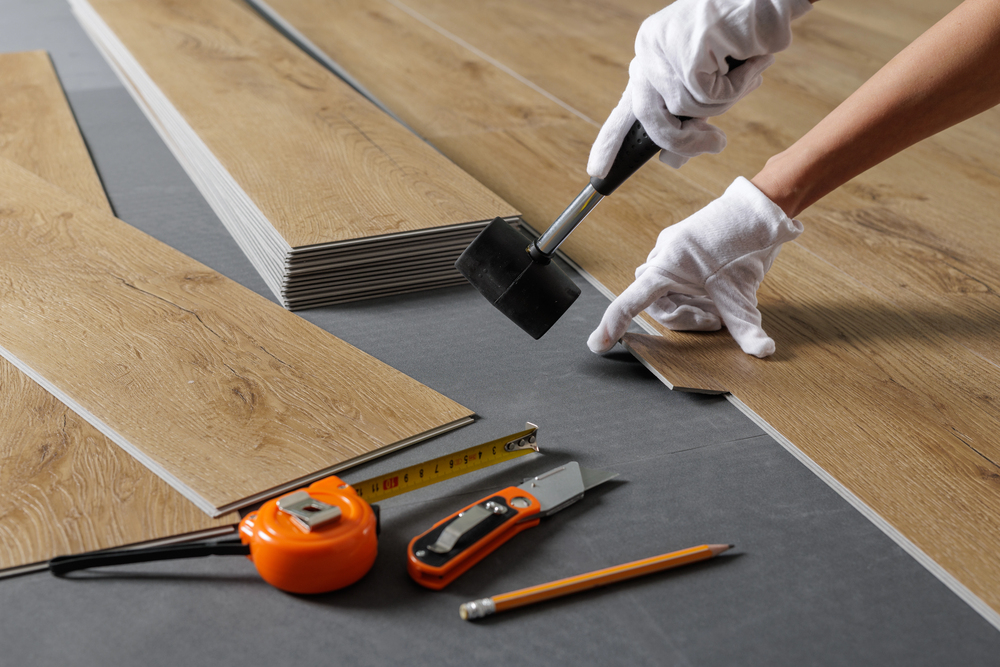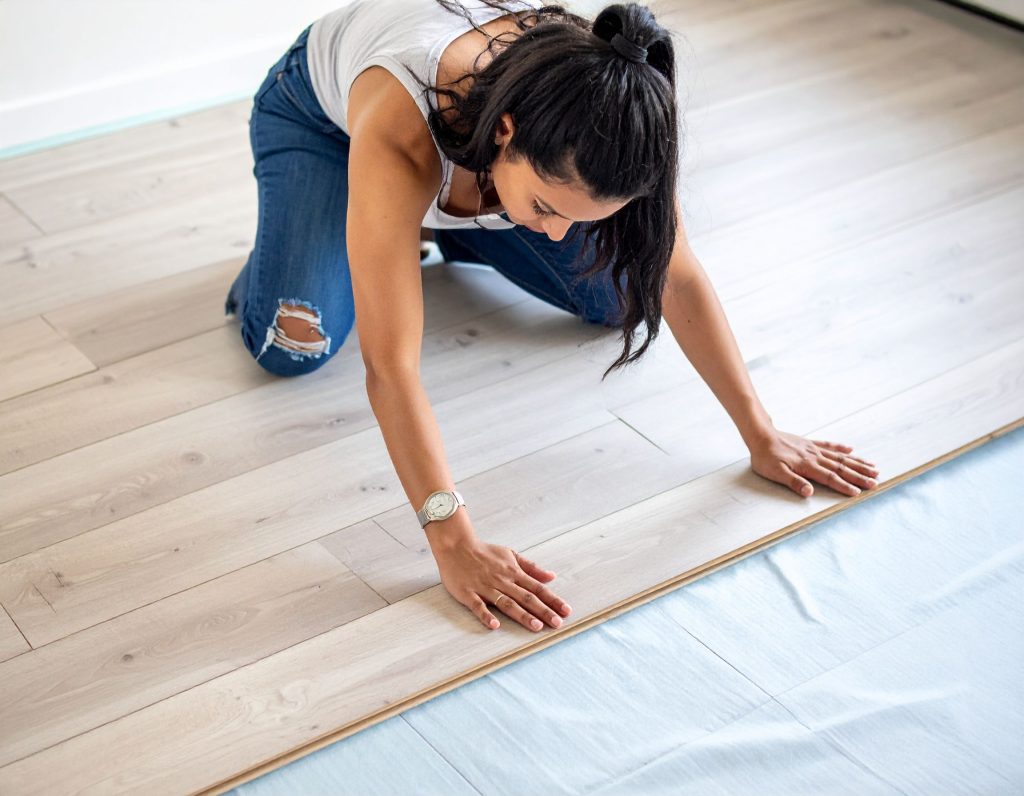Luxury Vinyl Tile (LVT) is one of the most versatile and practical flooring options available today. With its durability, water resistance, and realistic designs, LVT works beautifully in kitchens, bathrooms, living rooms and more. But a question we hear often at FunkyFlooring: “Can I lay LVT over my existing floor?”
The answer is usually yes – but the success of your installation depends on the type of subfloor. In this guide, we’ll cover chipboard, floorboards, plywood, concrete, existing vinyl, tile and asbestos tiles, plus essential tips and a handy FAQ to help you make an informed decision.
Can You Lay LVT Over Chipboard?
Yes, but preparation is key. For LVT installation, the chipboard should ideally be P5–P7 grade, dry, flat, and securely fixed. Low-grade or damaged chipboard can flex under weight, which may cause the vinyl to crack, buckle, or gap over time.
Pro Tip: For extra stability, lay a 6mm flooring-grade plywood overlay. This creates a smooth, rigid base and helps prevent squeaks or imperfections from showing through. Always check moisture levels before installation.
Can You Lay LVT Over Floorboards?
You can, but caution is needed. Traditional floorboards may have gaps, uneven surfaces, or movement that can cause issues with your LVT.
Best Practice: Install a plywood subfloor first: 8mm thick sheets, secured tightly. This creates a level, stable foundation, reducing the risk of visible imperfections .
Pro Tip: Fix any loose or squeaky boards before laying the plywood.
Can You Lay LVT Over Plywood?
Absolutely. LVT installs easily over plywood, especially 8mm or thicker sheets. The subfloor must be level, clean, and dry. Minor imperfections can be smoothed with a self-levelling compound.
Pro Tip: Countersink all screws and ensure joints are tight to avoid bumps in the vinyl.
Can You Lay LVT Over Concrete?
Yes, concrete is a common subfloor for LVT, but preparation is essential:
- Cure Time: Allow new concrete to cure at least 60 days.
- Moisture Test: Concrete must be dry to avoid adhesive or vinyl problems.
- Level Surface: Fill dips or bumps with leveling compound.
- Moisture Barrier: Use one if installing floating LVT.
Pro Tip: Wipe the surface with a damp cloth. If moisture appears, allow full drying before installation.
Can You Lay LVT Over Existing Vinyl Flooring?
Yes, as long as the vinyl is flat, clean, and firmly adhered. Avoid cushioned or damaged vinyl, as imperfections may telegraph through.
Pro Tip: Use a levelling compound for minor imperfections and consider a floating LVT installation for easier future removal.
Can You Lay LVT Over Tiles?
Yes, LVT can be installed over tiles if they are secure and level. Grout lines and uneven tiles should be filled with a floor leveling compound. Floating LVT is usually preferred over glue-down installations.
Pro Tip: Tap tiles to check for loose ones. Repair any hollow or broken tiles before installation.
Can You Lay LVT Over Asbestos Floor Tiles?
Yes, but with caution. Installing LVT over intact asbestos-containing vinyl tiles (VAT) is a process called encapsulation, which seals the asbestos and prevents fibre release.
Guidelines:
- Condition Check: Tiles must be intact and firmly adhered. Damaged tiles require removal by a licensed professional (allaboutasbestos.co.uk).
- Installation Method: Floating LVT is preferred to avoid disturbing the underlying tiles (houzz.com).
- Safety First: Never sand, scrape, or cut asbestos tiles.
Pro Tip: Have a certified asbestos professional assess your subfloor before starting.

Comparison Table: LVT Installation Over Subfloors
| Subfloor Type | Direct LVT Installation | Recommended Preparation |
|---|---|---|
| Chipboard (P4–P7 Grade) | ✅ Yes | Flat, dry, secure; optional 6mm plywood overlay. |
| Floorboards | ❌ Not recommended | Install plywood; fix loose boards; level surface. |
| Plywood | ✅ Yes | 8mm+ sheets; level; screws countersunk; level imperfections. |
| Concrete | ✅ Yes | Dry, cured ≥60 days; level; moisture barrier if needed. |
| Existing Vinyl Flooring | ✅ Yes | Flat, clean, firmly adhered; level imperfections. |
| Tile | ✅ Yes | Secure tiles; level grout lines and uneven areas. |
| Asbestos Floor Tiles (Intact) | ✅ Yes | Floating LVT; intact tiles; consult asbestos professional. |
| Asbestos Floor Tiles (Damaged) | ❌ No | Removal by licensed asbestos professional required. |
Frequently Asked Questions About LVT Installation
Can I Lay LVT Over Underfloor Heating?
Yes! LVT works with most underfloor heating systems. Use gradual heat increases and follow manufacturer guidelines. Floating LVT is preferred.
Can I Lay LVT Over Uneven Floors?
Minor imperfections can telegraph through. Use a self-leveling compound or underlayment to create a smooth, level surface.
How Long Will LVT Last on Different Subfloors?
- Plywood or Concrete: 20–25 years
- Floorboards or Chipboard: 15–20 years with plywood overlay
- Existing Vinyl or Tile: 15–20 years
- Asbestos Tiles (Encapsulated): 15–20 years
How Do I Maintain My LVT Floor?
- Sweep or vacuum regularly
- Mop with a mild cleaner
- Avoid abrasive tools or harsh chemicals
- Use protective pads under furniture
Can LVT Be Removed Later Without Damaging the Subfloor?
Yes, especially if installed as a floating floor. Glue-down LVT may require careful removal. Encapsulated asbestos tiles should never be disturbed.
LVT on top of existing floors
LVT is a highly adaptable flooring solution suitable for almost any subfloor when proper preparation is followed. From chipboard to concrete, and even intact asbestos tiles, you can enjoy a durable, stylish, and low-maintenance floor: provided you choose the right installation method and follow safety guidelines.


